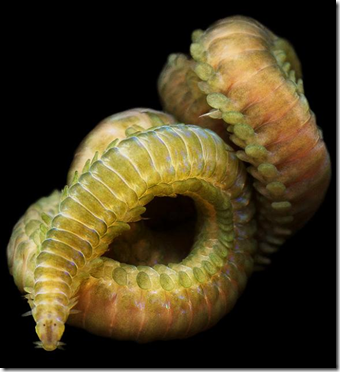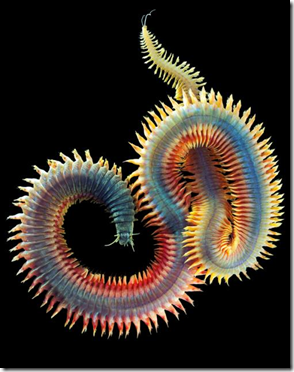20 Freakish Creatures from the Depths of Russia's White Sea
By Simone Preuss, Environmental Graffiti, 21 May 2012.
It is silent, disturbingly silent, in the dark depths of Russia’s White Sea. Only photographer Alexander Semenov’s diving gear creates a steady noise as a stream of bubbles floats upwards to the surface. Suddenly, a strange and bright red creature comes zooming in front of his lens, lending credence to its name, Red Bull (Acanthonotozoma inflatum). Luckily, this creature is miniscule by comparison with its terrestrial namesake, or else Semenov might have been in serious trouble! Let’s take a look at some the strangest creatures this intrepid photographer has encountered underwater.
Clione limacina is a sea angel, a type of sea slug. It’s commonly known as the naked sea butterfly, and looking at it you can definitely see why. Like other sea angels, it has wing-like appendages and is shell-less. In this image, the Clione has an almost prayer-like stance, and its upturned ‘wings’ make its name seem apt indeed. It’s easy to see why sea angels are some of photographer Semenov’s favourite deep-sea creatures (also featured previously on Environmental Graffiti).
Though unassuming in appearance, Russian zoologist Alexander Semenov is a giant when it comes to enriching the world’s knowledge about tiny (but no less weird and wonderful!) sea creatures. Employed by the White Sea Biological Station (WSBS), he began taking his camera with him a few years ago while going on dives. After showing his colleagues a few decent shots he’d managed to take, the WSBS invested in semi-professional photographic equipment that’s now Semenov’s constant companion when diving in the White Sea.
Here, we have two snail-like Precuthona sp. of the nudibranch suborder, and it looks like they've been caught in a bit of a playful mood! Apart from the yellowish oral tentacles attached to their heads (known as cephalic tentacles), these two rare, white sea slugs have various other tentacles along their back and sides called cerata. In many species of aeolid nudibranchs, the cerata form part of the digestive system: the stinging cells of the animals they feed on - everything from anemones to Portuguese man–of–wars - are passed through to the tips of the tentacles where they help protect the sea slug from attack. Now that's what we call some nifty recycling!
The White Sea, by the way, can be found on Russia’s northwest coast, and is an inlet of the Barents Sea, located to the north. It’s not too far from Scandinavia, if you want a general sense of where it is on Earth!
Although it’s kind of hard to make out what the photo depicts, it’s Cirratulus cirratus, a bristle worm that shows itself here in its cocoon form. After the female egg cells (oocytes) of C. cirratus have been fertilized, the jelly-like blob gets stuck to a rock. The larvae then hatch after six days, at which point they survive by feeding on the yolk sac for roughly another three weeks.
Alexander Semenov graduated from Moscow State University in 2007. He specialized in studying invertebrates, animals without backbones. Interestingly, only 3% of all creatures on the planet are not invertebrates; they’re vertebrates, the group that includes the generally larger animals - fish, amphibians, reptiles, birds, and mammals like us.
Oceans make up about 71% of the Earth’s surface, and because of their depth, there is 300 times more habitable space there than there is on land. Much of the life on our planet thus exists in the oceans, and just as on land, invertebrates make up a massive proportion of those organisms. And what’s more amazing is that due to the vastness of the oceans, many species have not yet been discovered! An exciting state of affairs for a photographer like Semenov, who goes on diving expeditions with his camera practically every day.
This strange-looking critter is another nudibranch, and looking at its various tentacles, the “branch” part of the name seems particularly apt. This Dendronotus dalii looks to be translucent, and though you might be tempted to think of it as a bit ghostly, we think it’s actually a bit of a cutie!
Looking somewhat flea-like, this large-eyed amphipod is Hyperia galba. Only growing up to 12 mm (0.5 in) in length, it’s a tiny critter that’s usually hidden in the flesh of jellyfish - because that’s where it lives. Yep, there it nestles, feeding off its host’s egg mass or food remnants. Yum!
“I'm not a scientist in the modern meaning, I'm more a naturalist, like Linnaeus in the 18th century,” Semenov has said, surely speaking with an adventurous twinkle in the eye. “I study all marine life and try to illustrate it and show to all people who are interested in environmental sciences and nature at all.” Looking at these stunning images, we’re grateful Semenov has found his calling!
This beautiful snail, with what resemble wings - or perhaps big ears - is Limacina helicina, another sea butterfly. The wing-like appendages are called parapodia, sideways-pointing protrusions evident in two groups of invertebrates. This beautiful capture shows the alien qualities of this deep-sea creature, a kind of bizarre Dumbo of the depths that is also one of Semenov’s favourites.
Capturing deep-sea creatures on camera like this is not always easy, as only some marine species can be photographed in their natural environment. As Semenov explains: “Some animals are too small, some spend their life burrowed in the seafloor, and some live in the dark depths where nobody can dive.” Different specimens are collected and taken to the lab, with some photographed there.
Similar to Precuthona sp., Coryphella nobilis has cerata, orange-coloured tentacles that are part of the digestive system in aeolid nudibranchs. This sea slug can reportedly grow to up 6.3 cm (2.5 in) in size, and here it looks like its cerata have LED-like white tips, which make it pretty cool in our eyes. Must be great for disco dancing in the deep sea!
This looks like one feisty creature, a headstrong little chap ready to troop into any adventure! It’s actually a crustacean, Pleustes panopla, first identified in 1838. With those glittering spots of light all over its body, it seems like a bit of a star to us.
This critter looks like a Chinese dragon, but of course is much smaller than the mythological beast, and it dwells not on land but in the ocean depths. It’s a marine worm called Phyllodoce citrina. Like all polychaetes (the class it belongs to), it’s characterized by a segmented body with a pair of bristle-covered fleshy outgrowths called parapodia on each segment. Though this specimen looks impressively long, polychaetes don’t usually grow beyond 10 cm (4 in) in length. Wouldn’t want to meet this guy in the murky depths if it were much bigger, and scarily, some of its polychaete cousins can grow up to 3 m (10 ft) long! Ulp!
Looking like a cross between a giant flea and a shrimp, this crustacean is Anonyx nugax. It’s an omnivore that’s both scavenger and predator, and it doesn’t look like something to fool around with if you’re potential prey down in the dark and gloomy depths.
If we didn’t know its actual proportions, we’d be inclined to think this green-leaf worm was actually a giant sea serpent. Like Phyllodoce citrina, the sweetly named Eulalia viridis belongs to the class of polychaete worms and has a segmented body. These little creatures, which range from 5 to 15 cm (2 and 6 in) in length, can have as many as 200 segments! Not one for being out in the open, this fellow commonly hides in all kinds of crevices or holds fast to barnacle and mussel beds.
Perhaps surprisingly, Coryphella polaris is a mollusk that belongs to the order of nudibranchs, the sea slugs we’ve encountered a few of today. Although nudibranchs often have a more stretched-out, slug-like appearance, this little chap seems to have a penchant for more of a spiral pose. A truly stunning capture! Is this Coryphella polaris doing its morning gymnastics, perhaps?
We weren’t shocked to learn that this marine creature is another that’s special to Alexander Semenov; indeed, as he says: “[M]y favourite mollusk is the very rare Coryphella polaris, a large nudibranch [sea slug], that lives under 30 m in the dark and cold water and is so beautiful - I just don't know any animal better."
Though this creature almost looks more like a flower than a sea creature (its body perhaps even resembles an elephant's trunk!), the segmented body is a clue that we’re dealing with another polychaeta, namely Pseudopotamilla reniformis, which was identified as far back as 1771. With its stunning good looks, we’re wondering why it hasn’t been gracing magazine covers since then!
Unfortunately, even in the depths of the White Sea, where tourism and diving are relatively scarce, garbage and the results of human activity can still be found here, as Alexander Semenov has seen for himself. “That's bad, but not critical - animals can live on it and in 3-5 years it disappears totally under the biomass,” says Semenov. But the photographer and marine expert cautions that should there be “any toxic waste, marine life will stop in this location for many years.” A chilling thought.
From the serious to the light-hearted, Ampharete sp. here invokes the strong suspicion that it was actually a star in The Muppet Show before its later career floating around in the White Sea. In reality, creatures of the Ampharete genus are polychaete worms (of the type we’ve seen) with what’s been described as “a single, chevron-shaped row of teeth.” Ugh! That’s rather scary sounding - but we still can’t help but be fond of this colourful little critter.
So strange-looking are these creatures, usually hidden from view in the depths of the sea, that one doesn’t ever really tire of looking at them. And just imagine: this is a tiny sample of Alexander Semenov’s collection, which must contain hundreds if not thousands of photographs. What’s more, as suggested, there must surely be thousands if not millions more marine creatures swimming around the world’s oceans that haven’t even been discovered yet!
Overall, a fascinating world that most of us would never see were it not for intrepid marine biologists with cameras like Alexander Semenov, who has opened this mesmerizing underwater universe to the world, and who graciously allowed us to use his images here.
Top image – Left: Bristleworm (Polychaeta Eteone longa). Right: Alitta (Nereis) virens. Photo: Alexander Semenov.


No comments:
Post a Comment
Please adhere to proper blog etiquette when posting your comments. This blog owner will exercise his absolution discretion in allowing or rejecting any comments that are deemed seditious, defamatory, libelous, racist, vulgar, insulting, and other remarks that exhibit similar characteristics. If you insist on using anonymous comments, please write your name or other IDs at the end of your message.